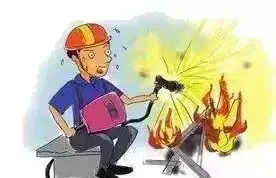Fire caused by welding in the paint room
A hazardous incident recently occurred in a spray paint room due to electric welding, spotlighting critical lapses in safety protocols and fire prevention measures. The incident unfolded when Welder A undertook the task of welding a workpiece within the spray paint room, inadvertently causing a cascade of electric welding sparks. These sparks splattered onto a nearby wooden board coated with a thick paint film, which promptly ignited. The panic among the workers present was palpable; some attempted to suppress the fire using brooms to beat at the flames, while others resorted to using compressed air in a misguided effort to control the blaze. Regrettably, these improvised fire-extinguishing methods were not only ineffective but exacerbated the situation, causing the fire to spread more rapidly and uncontrollably. The volatile mixture of paint and combustible materials facilitated a swift escalation of the fire, which continued raging for half an hour before firefighters managed to extinguish it. Although no personnel were injured, the fire resulted in severe property damage, posing a stark reminder of the critical importance of workplace safety regulations and emergency preparedness.
The investigation revealed three primary factors contributing to the accident. Firstly, the fire was never approved before conducting the hot welding work in an area designated as fire-prohibited. The decision to carry out welding in such a sensitive zone without proper authorization and adherence to operational procedures was a glaring oversight. Secondly, the hot work proceeded without the necessary preliminary steps, such as removing the paint film and other combustible materials from the room or implementing effective fire prevention measures. This negligence created a high-risk environment ripe for such an incident. Finally, the attempts to extinguish the fire were poorly executed, with improper use of compressed air not only failing to suppress the flames but actually propelling the fire further, amplifying the damage. These mistakes underline a broader systemic issue where emergency protocols were either unknown or blatantly disregarded by the workforce.

To prevent such accidents in the future, a multi-faceted approach to safety must be enforced. Firstly, the spray paint room must be strictly off-limits for any open flame operations. If welding within this area becomes indispensable, a stringent hot work approval system must be adhered to, ensuring all safety checks and protocols are thoroughly observed before commencement. Additionally, all combustible materials must be meticulously cleared from the vicinity to minimize any potential fire hazards. Adequate fire suppression tools such as sand, foam, or carbon dioxide fire extinguishers should be readily available and workers must be trained in their proper use. This incident serves as a grim reminder that the lack of diligence and preparedness in handling hot work and fire hazards can lead to devastating consequences. Rigorous training, adherence to safety protocols, and having the appropriate fire-fighting equipment on hand are non-negotiable elements in creating a safer work environment. Implementing these preventive measures not only safeguards property but, most importantly, protects human lives from the potentially catastrophic outcomes of fire-related accidents.
-
Only welders are allowed to perform welding workსიახლეებიOct.31,2025
-
Health hazards of plasma weldingსიახლეებიOct.23,2025
-
Pay attention to safety when weldingსიახლეებიOct.20,2025
-
Burned while exploring the welding environmentსიახლეებიSep.30,2025
-
Scalded by molten steel when exploring the depth of the slag poolსიახლეებიSep.23,2025
-
Fire during welding workსიახლეებიSep.16,2025


